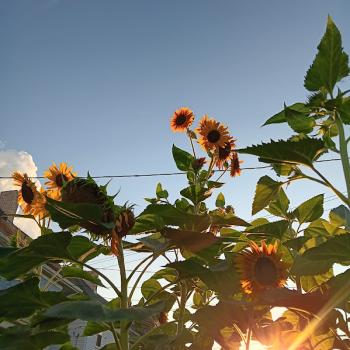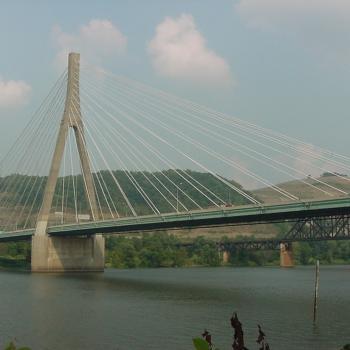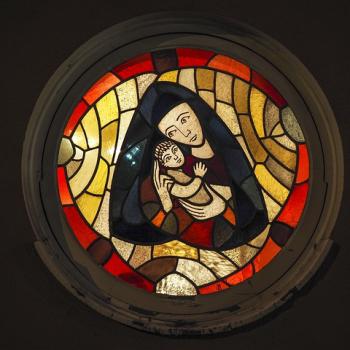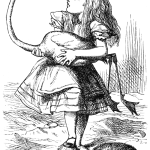
We’ve been going on drives.
Adrienne and I usually drive to the lake to go swimming, but sometimes we drive other places. We drove down to Wellsburg, where I once met that homeless woman, just to stand on the pier and feel the Ohio river tugging at it. On the way back we passed a log cabin built in 1788, when Wellsburg, West Virginia was called Buffaloe, Virginia, and Steubenville was nothing but a fort. We drove to Moundsville, to walk on that burial mound which was ten times older than the United States. We drove to Columbiana County, to see a two hundred-year-old gristmill and peer through the windows of a pioneer town.
Last week, it was miserably hot. Michael’s hours were cut in the month of July, because restaurants don’t do as much business in summer in a college town, so the money was tight and remains tight. It was far too humid to enjoy the lake beach or anywhere else out in nature, and we couldn’t afford to pay admission to anywhere indoors. But we wanted to go somewhere while Michael was at work.
“Let’s go to a small town we’ve never visited before,” I said, “and check out a book from the library.”
I suppose everyone has a patchwork of places nearby that they’ve never seen, dotting a map in their brain, like “Here there be dragons” on a Medieval chart. I have been to Cadiz but not Jewett or Scio. I’ve driven through Richmond all the way to Carrolton, but I’ve never been to Harlem Springs. I have been to Tiltonsville, but not to Dillonvale. All the public libraries in the county are on the same library system, so my card was valid in any of the small towns along the Ohio. It was only a matter of choosing one. We decided to go to the library in Dillonvale, a little over half an hour from here. Dillonvale isn’t right flush against the river. It’s inland, towards the edge of Jefferson county.
Where I grew up in Columbus, in the Midwest, the ground was very flat and easy to build on. I lived five miles from downtown, but I could see the skyscrapers in the distance when I was on High Street. There wasn’t a barrier between the city and the other towns in the metro area. You could go to Worthington or Westerville without knowing you’d left Columbus. The Valley isn’t like that. The Valley is a mess of shale hills that break up the horizon so you can’t see. There are cricks and valleys and shale cliffs that buckle and slide. One minute you’re in a town, and then you’re in farmland, and then you’re nowhere. This makes it fun to go exploring.
We drove down Route Seven at first. I don’t know how long that leg of the journey would take if the road weren’t under construction. That stretch of highway has been under construction for as long as I can remember. Every time they think they’ve got Route Seven ready to open up, we have another landslide. Shale is a noisy rock, easily shattered, that is stacked in layers like a tower of crêpes. In the spring thaws or after a bad storm, some of that shale gives way. It goes clattering onto the southbound lane or slips out from under the northbound lane into the Ohio, and then they have to build Route Seven again. For this reason, Route Seven near Mingo Junction has always been a one-lane maze of orange barrels.
We navigated the barrels past the Logan Street exit, near where General George Washington stopped to drink from a spring in the shale rock and returned to Virginia, never to go further west in his life. We got off the freeway at the Rayland exit. They say there’s another Adena burial mound there, not the celebrated one in the pioneer cemetery but another one, in the middle of a construction warehouse’s yard. Up over some land that looks like a marsh but isn’t, and out across the railroad tracks. I am told that in the heyday of industry in the Ohio Valley, the trains came all the time. The sky was steel gray with smoke from all the chimneys, and the earth was so filthy that snow turned black on the ground. But you hardly ever have to stop for a train nowadays, in Rayland. The sky is blue. The trees are green. The shale is the color of rust.
We drove inland, away from the river.
The country roads in that part of the world follow the cricks and valleys, so they meander. It took longer than I thought to get out of Rayland. I kept thinking we’d gone too far, but Adrienne would check the map on the phone and declare we weren’t far enough yet. At one point, there’d be a farm with a house that wouldn’t look out of place a hundred years ago. At another point, a school with gleaming new windows and an immaculate blacktop parking lot. Further on, the road was hemmed in with shale cliffs that looked ready to cascade down into the crick.
And then we were in Dillonvale, a village of six hundred people with the shale hills hemming it in. There was a church there, and a dollar store, and an Italian restaurant.
Right in the middle at a weird zigzagging intersection, tucked behind the post office, was the library.
We went out of the air conditioning into the boiling humidity of an Appalachian July, squinting in the bright afternoon. It felt like crossing the surface of a sun-baked planet just to cross the parking lot. When we got inside, it was air conditioned and quiet, perfumed with the smell of books. There were computers and leather easy chairs, and a pleasant librarian who asked if we needed anything. The towns around the Ohio are all strange and mysterious to me, and no one is very like the other. But the libraries are all the same. Step into one of the libraries, and you feel at home.
We sat in the library and looked at books for awhile, feeling like explorers who’d just put down anchor in a safe harbor.
There was a time when I thought Northern Appalachia was ugly.
We got home in time to pick Michael up from work, excited as if we’d been on a marvelous adventure. And perhaps we had been.












